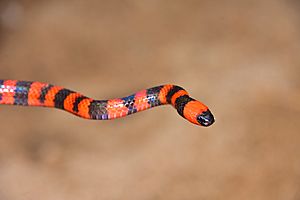Roatan coral snake facts for kids
The Roatán coral snake (Micrurus ruatanus) is a special kind of snake found only on the island of Roatán. This island is off the coast of Honduras in Central America. This snake is also known as Coral de la Isle de Roatán or Coral Roatanense in Spanish. It is a critically endangered species, which means it is very close to disappearing forever.
Quick facts for kids Roatan coral snake |
|
|---|---|
 |
|
| Conservation status | |
| Scientific classification | |
| Synonyms | |
|
Contents
About the Roatán Coral Snake
The Roatán coral snake is a type of elapid snake. Elapids are a family of snakes that include cobras and mambas. They are known for having venom. This snake was first described by a scientist named Albert Charles Lewis Günther in 1895.
What Does It Look Like?
Like many coral snakes, the Roatán coral snake likely has bright, striking colors. These colors often include patterns of red, yellow (or white), and black bands. These bright colors are a warning sign to predators. They tell other animals that the snake is venomous.
Where Does It Live?
This snake is endemic to Roatán. This means it lives naturally only on this one island and nowhere else in the world. Roatán is a beautiful island known for its coral reefs and lush forests. The snake probably lives in the forests and hidden areas of the island.
What Does It Eat?
Most coral snakes eat other snakes, lizards, and sometimes frogs. The Roatán coral snake likely has a similar diet. It uses its venom to catch its prey. It is an important part of the island's food web.
Why Is It Endangered?
The Roatán coral snake is critically endangered. This means its population is very, very small. There are several reasons why animals become endangered. For this snake, it is likely due to habitat loss. As more people move to Roatán, forests are cut down. This takes away the snake's home and hunting grounds.
Another threat could be the introduction of new animals. These new animals might eat the snakes or compete for their food. Because the snake lives only on one island, it is more vulnerable. If something bad happens on the island, the whole species is at risk.
Protecting This Snake
Protecting the Roatán coral snake is very important. Scientists and conservation groups are working to save endangered species. This often involves protecting their natural habitats. It also means educating people about the importance of these animals.
Efforts might include creating protected areas on Roatán. This would give the snakes a safe place to live and reproduce. Learning more about the snake's habits and needs also helps. Every effort to protect its home helps this rare snake survive.
See also
 In Spanish: Micrurus ruatanus para niños
In Spanish: Micrurus ruatanus para niños


